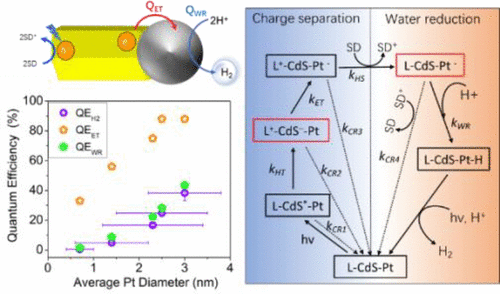当前位置:
X-MOL 学术
›
J. Am. Chem. Soc.
›
论文详情
Our official English website, www.x-mol.net, welcomes your
feedback! (Note: you will need to create a separate account there.)
Pt Particle Size Affects Both the Charge Separation and Water Reduction Efficiencies of CdS–Pt Nanorod Photocatalysts for Light Driven H2 Generation
Journal of the American Chemical Society ( IF 14.4 ) Pub Date : 2022-01-28 , DOI: 10.1021/jacs.1c11745 Yawei Liu 1 , Wenxing Yang 1, 2 , Qiaoli Chen 1, 3, 4 , David A Cullen 5 , Zhaoxiong Xie 3 , Tianquan Lian 1
Journal of the American Chemical Society ( IF 14.4 ) Pub Date : 2022-01-28 , DOI: 10.1021/jacs.1c11745 Yawei Liu 1 , Wenxing Yang 1, 2 , Qiaoli Chen 1, 3, 4 , David A Cullen 5 , Zhaoxiong Xie 3 , Tianquan Lian 1
Affiliation

|
Decreasing the metal catalyst size into nanoclusters or even single atom is an emerging direction of developing more efficient and cost-effective photocatalytic systems. Because the catalyst particle size affects both the catalyst activity and light driven charge separation efficiency, their effects on the overall photocatalytic efficiency are still poorly understood. Herein, using a well-defined semiconductor–metal heterostructure with Pt nanoparticle catalysts selectively grown on the apexes of CdS nanorods (NRs), we study the effect of the Pt catalyst size on light driven H2 generation quantum efficiency (QEH2). With the increase of the Pt catalyst size from 0.7 ± 0.3 to 3.0 ± 0.8 nm, the QEH2 of CdS–Pt increases from 0.5 ± 0.2% to 38.3 ± 5.1%, by nearly 2 orders of magnitude. Transient absorption spectroscopy measurement reveals that the electron transfer rate from the CdS NR to the Pt tip increases with the Pt diameter following a scaling law of d5.6, giving rise to the increase of electron transfer efficiency at larger Pt sizes. The observed trend can be understood by a simplified kinetic model that assumes the overall efficiency is the product of the quantum efficiencies of charge separation (including hole transfer, electron transfer, and hole scavenging) and water reduction steps, and for CdS–Pt NRs, the quantum efficiencies of electron transfer and water reduction steps increase with the Pt sizes. Our findings suggest the importance of improving the quantum efficiencies of both charge separation and catalysis in designing efficient semiconductor–metal hybrid photocatalysts, especially in the regime of small metal particle sizes.
中文翻译:

Pt 粒径影响 CdS–Pt 纳米棒光催化剂的电荷分离和水还原效率,用于光驱动制氢
将金属催化剂的尺寸减小为纳米团簇甚至单原子是开发更高效、更具成本效益的光催化系统的新兴方向。由于催化剂粒径影响催化剂活性和光驱动电荷分离效率,因此它们对整体光催化效率的影响仍然知之甚少。在此,我们使用定义明确的半导体-金属异质结构和在 CdS 纳米棒 (NRs) 的顶点上选择性生长的 Pt 纳米颗粒催化剂,研究了 Pt 催化剂尺寸对光驱动 H 2产生量子效率 (QE H 2 ) 的影响。随着 Pt 催化剂尺寸从 0.7 ± 0.3 增加到 3.0 ± 0.8 nm,QE H 2CdS–Pt 从 0.5 ± 0.2% 增加到 38.3 ± 5.1%,增加了近 2 个数量级。瞬态吸收光谱测量表明,从 CdS NR 到 Pt 尖端的电子转移率随着 Pt 直径的增加而增加,遵循d 5.6的比例定律,导致在较大 Pt 尺寸下电子转移效率的增加。观察到的趋势可以通过一个简化的动力学模型来理解,该模型假设总效率是电荷分离(包括空穴转移、电子转移和空穴清除)和水还原步骤的量子效率的乘积,对于 CdS-Pt NR,电子转移和水还原步骤的量子效率随着 Pt 尺寸的增加而增加。我们的研究结果表明提高电荷分离和催化的量子效率在设计高效的半导体-金属混合光催化剂中的重要性,特别是在小金属颗粒尺寸的情况下。
更新日期:2022-01-28
中文翻译:

Pt 粒径影响 CdS–Pt 纳米棒光催化剂的电荷分离和水还原效率,用于光驱动制氢
将金属催化剂的尺寸减小为纳米团簇甚至单原子是开发更高效、更具成本效益的光催化系统的新兴方向。由于催化剂粒径影响催化剂活性和光驱动电荷分离效率,因此它们对整体光催化效率的影响仍然知之甚少。在此,我们使用定义明确的半导体-金属异质结构和在 CdS 纳米棒 (NRs) 的顶点上选择性生长的 Pt 纳米颗粒催化剂,研究了 Pt 催化剂尺寸对光驱动 H 2产生量子效率 (QE H 2 ) 的影响。随着 Pt 催化剂尺寸从 0.7 ± 0.3 增加到 3.0 ± 0.8 nm,QE H 2CdS–Pt 从 0.5 ± 0.2% 增加到 38.3 ± 5.1%,增加了近 2 个数量级。瞬态吸收光谱测量表明,从 CdS NR 到 Pt 尖端的电子转移率随着 Pt 直径的增加而增加,遵循d 5.6的比例定律,导致在较大 Pt 尺寸下电子转移效率的增加。观察到的趋势可以通过一个简化的动力学模型来理解,该模型假设总效率是电荷分离(包括空穴转移、电子转移和空穴清除)和水还原步骤的量子效率的乘积,对于 CdS-Pt NR,电子转移和水还原步骤的量子效率随着 Pt 尺寸的增加而增加。我们的研究结果表明提高电荷分离和催化的量子效率在设计高效的半导体-金属混合光催化剂中的重要性,特别是在小金属颗粒尺寸的情况下。









































 京公网安备 11010802027423号
京公网安备 11010802027423号